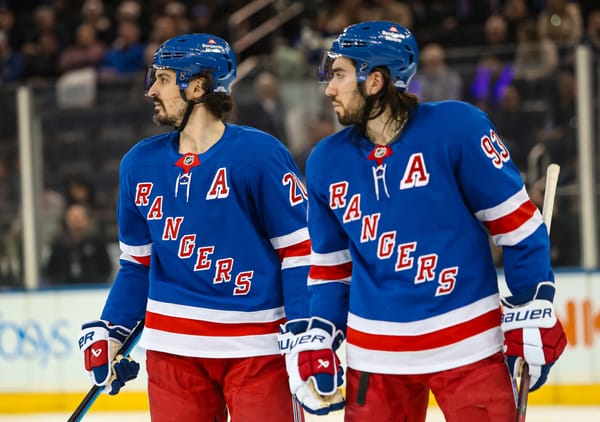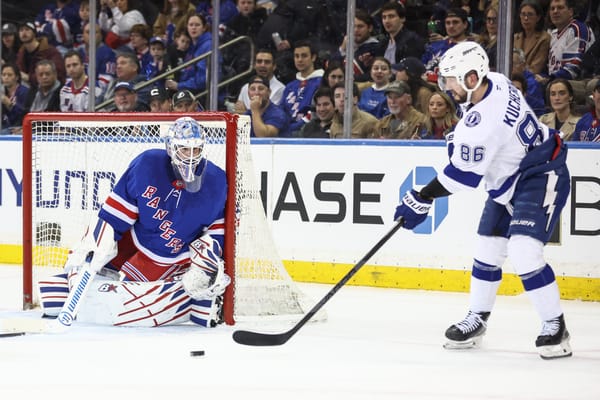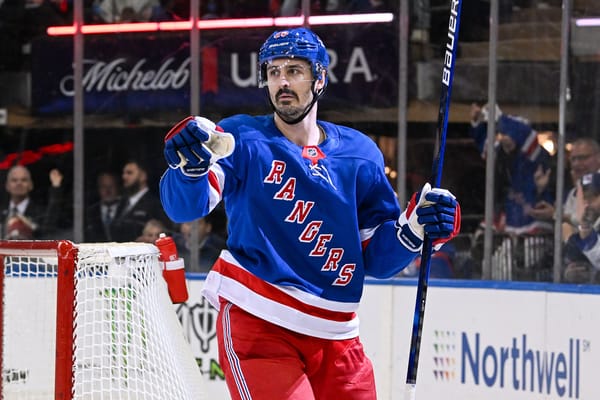The Advantages the Rangers Will Have at the Draft Table
In theory, the objective for every NHL team at the NHL Draft is to pick the best player available. Teams are weighing skillsets, character, injury history, fitness testing, and perceived upside, and every team will come to different conclusions on who that may actually be. But the idea is supposed to be the same for all involved.
In practice, there are other influences that can lead to teams picking a player besides the one it happens to believe to best fit that criteria in a vacuum. Sometimes, that can be an active choice in self-sabotage, such as reaching for positional need. Most of the time, it’s a result of pressures of the job, NHL politics, and the state of an organization.
The state of a team’s depth chart and prospect pool can influence what risks a team believes it can take. Consider a team such as the New York Islanders. Yes, they have a few fantastic young players, but broadly speaking they are not built for the future. They have one of the oldest teams in the league and a prospect pool that the consensus ranks as average at best. Their earliest pick in 2020 is 90th overall and they lack a second-round pick in 2021.
If you’re a major decision-maker at the Islanders’ draft table next year, you have little margin for error and the pressure is on to absolutely nail that first-round pick. The team has to have something to show for that pick in a few years or else it could be in deep trouble.
One NHL scout acknowledged that that kind of situational reality can, at least in part, change what player a team might land on as their best bet with a higher draft pick.
“It’s more of the ‘safe’ pick versus the swing for the fences pick. Like take the safe defensive defenseman or the safe two-way forward,” as one NHL scout, who is not employed by the Rangers, told Blueshirt Banter.
Organizational stability can also play a huge role in what scouts or executives might decide to do at the draft table. Yes everyone within an organization is part of a team trying to win hockey games, but like anyone else, they are working jobs that pay bills and are looking out for their own careers as well.
Consider that you are a scout or executive for a team that hasn’t lived up to ownership’s expectations the last few seasons. but believe he comes with tremendous risk and will experience massive growing pains in his early developmental years. Or, he’s a European or college-bound and you’re going to have to wait a while for him to enter your pro ranks. Even if that player turns a corner and becomes a success five years from now, your contract expires in two years and there’s a 50/50 shot you’ll be long gone before the organization even reaps the rewards.
Maybe there’s a different prospect available whom you believe offers a better chance at instant gratification. He may not have superstar upside, but he’s a safe bet to make a World Junior Roster next year, establish himself as a valuable prospect early, and either make the NHL quickly or offer value as a trade chip as your team makes a push to achieve success, possibly saving your job and earning you a contract extension.
Now you’re not only weighing the cost-benefit analysis of draft picks for the organization’s future, but at least, a little bit, your own.
“Yeah of course it plays a part. Especially if you don’t trust the person above you,” said the NHL scout.
That’s not to say that teams won’t make bold decisions in the team’s best interest regardless, but it’s at least one factor that can, even if in only a small way, linger at the draft table and subconsciously affect proceedings.
The Rangers are pretty insulated from those factors, and it’s a major advantage for them heading into next Tuesday. Particularly with their 22nd overall pick in the first round.
The team possesses an immense collection of young talent at all levels of the organization. Most outsiders rate them as having the top prospect pool in the NHL, and that’s before considering the addition of Alexis Lafreniere at first overall. They own their first-round pick in 2021, and while they have traded their second-rounders for this season and next, they have multiple picks in the middle rounds both years to compensate.
Every asset matters, but the future of the team isn’t going to live and die by the 22nd overall pick.
The organization is incredibly stable. That is not an evaluation of how good or bad anyone is at his or her job, but rather an acknowledgement that ownership has total confidence in the current structure on the whole. President John Davidson was added only just a year ago and he has possibly the most secure job in the NHL of any executive. General Manager Jeff Gorton appears perfectly safe in his role. Assistant GM Chris Drury is highly thought of internally and, if he leaves in the near future, it will be on his own volition. Head of North American Scouting, Chris Morehouse, was a Davidson recruit just last summer.
It wouldn’t be a surprise to see Davidson tinker now that he’s had a year to evaluate the internal workings of the organization, but most major decision-makers are secure in their employment. With stable management and a prospect pool rich with both upside and immediacy, the Rangers are granted freedom to do more or less as they please.
“If you’re the Rangers, you take Lafreniere and then swing at 22. You got a free ticket with Lafreniere,” the scout remarked as his ideal strategy if he were in the Rangers’ position.
That does not automatically mean the Rangers will go boom-or-bust with that pick (assuming they don’t trade it outright). Perhaps the draft plays out in a manner in which the Rangers feel most comfortable selecting Dylan Holloway, a center at Wisconsin who is a safe bet to turn pro soon and make an NHL roster in some capacity. Or perhaps Kaiden Guhle, a left defenseman whose mobility and defensive reads make him arguably the most likely prospect outside the consensus top-10 to be in the NHL in two years.
What it does mean, however, is that the Rangers are afforded latitude that other organizations might not.
“A guy like Hendrix Lapierre would be a big swing. Great player, but if he gets another concussion....” said the scout.
Or, their ability to take a patient approach could lead to the team drafting Rodion Amirov or Noel Gunler, two highly skilled wingers in Russia and Sweden respectively who are working on strength training and diversifying their games and who may not sign NHL contracts for three, maybe even four years.
Ultimately, the Rangers’ pick at 22nd overall will only be as good as scouting allows it to be, not to mention the influence of post-draft development and pure luck. But with secure management and an already successful youth movement, fear of failure itself will not be an obstacle the Rangers will be facing. The organization, and the actors within it, have the freedom to get it wrong. That provides confidence which might be needed to gamble on a player who, if they get it right, could eventually prove to be a steal.




